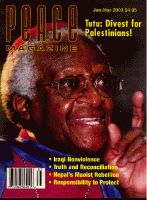
Peace Magazine Jan-Mar 2003, page 30. Some rights reserved.
Search for other articles by Shirley Farlinger here
Dr. Helen Caldicott: The New Press, New York. 2002. 263 pp
In 1982 the National Film Board of Canada produced "If You Love This Planet," an award-winning film of Dr. Helen Caldicott as she lectured on the effects of one nuclear bomb dropped on one city and urged large audiences to stop the Mutual Assured Destruction (MAD) nuclear policy of the Cold War.
As it turns out we did not love this planet enough to end the nuclear threat to our world. Her closing statement that "You're going to have to change the priorities of your life" has not applied to enough people yet. Caldicott described nuclear technology as a malignant cancer metastasing rapidly. She was right. Twenty years has seen the expansion of nuclear weapons to states such as India and Pakistan and horrendous new nuclear and "near nuclear" technology.
Crusader Caldicott has again interrupted her medical practice in Australia, which she loves, to travel and lecture with her new book on the new nuclear dangers.
The US President is surrounded by advisors tempted to use nuclear weapons. "Secretary of Defense Donald Rumsfeld refused to rule out the use of nuclear weapons in this war" (on Afghanistan).
Military production continues. Lockheed Martin, the number one contractor for the Pentagon, NASA and the Department of Energy, along with Boeing and Raytheon are the three major military producers after several mergers which left fewer companies but the same amount of production now with higher costs. Lockheed Martin received $1.2 billion in taxpayer money and is the largest advocate of aggressive nuclear development.
What is being developed? Caldicott tells the reader all you should know about the plans for nuclear weapons that will be earth-penetrating, depleted uranium encased, faster, stealthier, longer-range, and more computerized. The dangers are immense as, for the first time, foreign nationals may get access to nuclear weapons design through their universities, Caldicott says.
In Afghanistan there was carpet bombing by B-52 planes at 40,000 feet and unmanned drones (pilotless planes with Hellfire missiles) guided from afar. The press of a button can launch 2,500 of the 7,206 weapons available now.
Then there are the nuclear-related possibilities: small suitcase Russian nuclear weapons (10 have been lost); theft of nuclear material (153 confirmed cases); nuclear meltdowns of nuclear power plants by jets (the US has 103 plants, there are 438 in the world); and large numbers of storage sites of nuclear material - all vulnerable to terrorists.
Caldicott aims to make clear the international arms race which the US is promoting and which will lead to the militarization of space and possible nuclear winter. "And hardly anybody is watching. That's why I wrote this book," Caldicott declares.
There's no doubt we missed many opportunities to de-militarize. Even the treaties which were signed, ABM, NPT, Outer Space Treaty, are now being overturned or ignored by the US.
Nuclear weapons that workers happily made to defend and deter in the certainty that they were only there to indicate a strong-willed nation are now part of a first strike system by a nation on the brink of placing nukes even in space.
How can I persuade readers to read a book so chilling in its inescapable conclusions? Look at it this way. Your doctor has diagnosed you with septicemia but you don't know what that is. Wouldn't you try to find out before it was too late?
This is similar. We have an addiction to militarism and to using weapons of mass destruction to settle political problems and this addiction is depriving people of the means of improving their lives as well as causing immense suffering and death in wars.
The video "If You Love This Planet" is available from the National Film Board, 1-800-267-7710, $19.95. 26 minutes.
A Keen Soldier: The Execution of Second World War Private Harold Pringle By Andrew Clark. Knopf 2002

Peace Magazine Jan-Mar 2003, page 30. Some rights reserved.
Search for other articles by Shirley Farlinger here